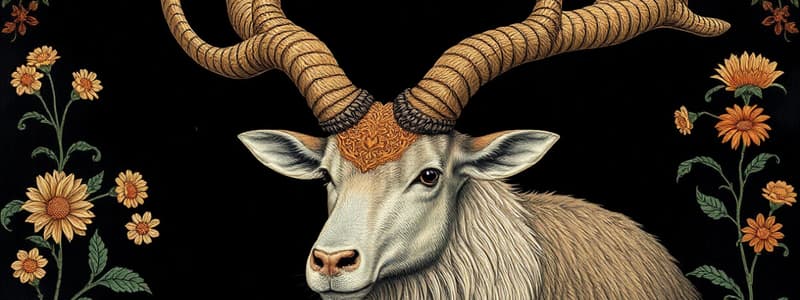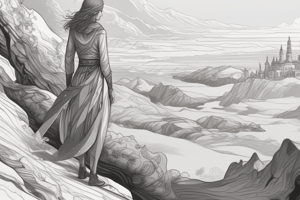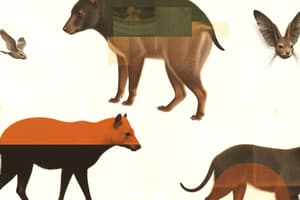Podcast
Questions and Answers
Which characteristic is unique to all mammals?
Which characteristic is unique to all mammals?
- Specialized placenta (correct)
- Presence of fur
- Ability to hibernate
- Horns
What differentiates horns from antlers in terms of physical structure?
What differentiates horns from antlers in terms of physical structure?
- Horns do not have forks or prongs (correct)
- Horns are made of bone
- Horns are shed annually
- Antlers are more social than horns
Which family includes species like deer and moose?
Which family includes species like deer and moose?
- Family Cervidae (correct)
- Family Antilocapridae
- Family Felidae
- Family Bovidae
How do grazing and browsing mammals primarily differ?
How do grazing and browsing mammals primarily differ?
What is a common misconception about bison?
What is a common misconception about bison?
What characteristic is common to all male deer, with one exception?
What characteristic is common to all male deer, with one exception?
Which deer species is known for its stotting or pronking behavior?
Which deer species is known for its stotting or pronking behavior?
What is the primary habitat preference for mule deer compared to white-tailed deer?
What is the primary habitat preference for mule deer compared to white-tailed deer?
Which species was nearly eliminated from eastern North America and Mexico by 1903?
Which species was nearly eliminated from eastern North America and Mexico by 1903?
What color are wapiti in summer?
What color are wapiti in summer?
Which feature differentiates white-tailed deer from mule deer?
Which feature differentiates white-tailed deer from mule deer?
What is the most significant consequence of agriculture and forest fragmentation for white-tailed deer?
What is the most significant consequence of agriculture and forest fragmentation for white-tailed deer?
Which deer species has a distinct yellow-orange-white rump patch?
Which deer species has a distinct yellow-orange-white rump patch?
What physical characteristic distinguishes male mountain goats from females?
What physical characteristic distinguishes male mountain goats from females?
Which of the following statements about bighorn sheep is accurate?
Which of the following statements about bighorn sheep is accurate?
In what type of habitat do mountain goats prefer to live?
In what type of habitat do mountain goats prefer to live?
What is a unique feature of pronghorns compared to other horned animals?
What is a unique feature of pronghorns compared to other horned animals?
Which statement about wood bison is correct?
Which statement about wood bison is correct?
What adaptation helps bighorn sheep with stability on rocky ledges?
What adaptation helps bighorn sheep with stability on rocky ledges?
What role do mineral licks play for mountain goats?
What role do mineral licks play for mountain goats?
What term is used to reference the provincial mammal of Alberta, Canada?
What term is used to reference the provincial mammal of Alberta, Canada?
Flashcards
Mammal Characteristics
Mammal Characteristics
Key features that define mammals. These include hair, horns, antlers, specialized glands, a sophisticated placenta, and an advanced nervous system. Mammals are also endothermic, meaning they produce their own heat and are typically homeothermic, maintaining a stable body temperature.
Horns vs. Antlers
Horns vs. Antlers
Horns are made of compressed keratin, are permanent, and have one point. Antlers, on the other hand, are made of bone, are shed annually, and have multiple points or prongs.
Bovidae Family
Bovidae Family
A family of mammals including bison, bighorn sheep, and mountain goats. Members of this family are social grazers with horns, adapted to shearing grass using a hard dental pad.
Cervidae Family
Cervidae Family
Signup and view all the flashcards
Pronghorn
Pronghorn
Signup and view all the flashcards
Wood Bison
Wood Bison
Signup and view all the flashcards
Plains Bison
Plains Bison
Signup and view all the flashcards
Mountain Goat
Mountain Goat
Signup and view all the flashcards
Mountain Goat Horns
Mountain Goat Horns
Signup and view all the flashcards
Mountain Goat Hooves
Mountain Goat Hooves
Signup and view all the flashcards
Bighorn Sheep
Bighorn Sheep
Signup and view all the flashcards
Bighorn Sheep Horns
Bighorn Sheep Horns
Signup and view all the flashcards
Pronghorn Unique Feature
Pronghorn Unique Feature
Signup and view all the flashcards
Pronghorn Population Decline
Pronghorn Population Decline
Signup and view all the flashcards
Pronghorn Population Control
Pronghorn Population Control
Signup and view all the flashcards
Pronghorn Hunting
Pronghorn Hunting
Signup and view all the flashcards
Deer Family Distribution
Deer Family Distribution
Signup and view all the flashcards
Deer Male Distinguishing Feature
Deer Male Distinguishing Feature
Signup and view all the flashcards
Wapiti Physical Characteristics
Wapiti Physical Characteristics
Signup and view all the flashcards
Wapiti Population History
Wapiti Population History
Signup and view all the flashcards
Study Notes
Wildlife Biodiversity (ZO350) - Class Mammalia
- Mammals are a diverse class of animals, with about 4600 living species.
- Over 600 species are threatened due to habitat loss.
- They are the most highly differentiated group in the animal kingdom.
- Mammals exhibit a wide range of sizes, shapes, and functions.
- Some examples of influenced mammals include the bumblebee bat and the Etruscan pygmy shrew.
- The smallest mammal is the Etruscan shrew (Suncus etruscus), and the largest is the blue whale (Balaenoptera musculus).
Mammal Lineage
- Marsupials are not exclusively native to Australia.
- They are also found on Melanesian islands and in the Americas (primarily opossums).
- Mammal evolution shows a progression from early therian lineages to more recent placental mammals, including monotremes.
- The geological history (Paleozoic, Mesozoic, and Cenozoic) is reflected in the evolutionary branches of mammals.
- Cynodonts, pelycosaurs, and synapsids are important groups in early mammalian lineage.
- Prototherian lineages are egg-laying mammals.
- Metatherian lineages include marsupials.
- Eutherian lineages are placental mammals.
Mammal Family Tree (North America)
- This diagram depicts the evolutionary relationships among various mammal families in North America.
- Specific families mentioned include Manatees, Odd-toed Ungulates, Even-toed Ungulates, Whales, Dolphins, Porpoises, Primates, Bats, Carnivores, Rodents, Rabbits, Hares, Pikas, Anteaters and Sloths, Armadillos, and Opossums.
- A "★" symbol denotes a species prevalent in the Prairie Provinces.
Diversity of Mammals
- Key features of mammals include size, shape, form, and function.
- The images presented depict a wide range of mammal sizes.
- Human influence on mammals is substantial and has resulted in many species being threatened due to habitat loss.
Mammals Characteristics
- Mammals are characterized by hair, horns/antlers, glands, a specialized placenta, and a highly advanced nervous system (brain).
- They are endothermic, meaning they generate their own body heat.
- Most mammals are homeothermic, maintaining a constant body temperature.
- True hibernating is a trait of some mammals.
- In biology, exceptions to rules are common.
Hoofed/Undulates Mammals
- Specific families of hoofed animals are discussed (Bovidae, Cervidae, Antilocapridae).
- Bovidae (e.g., bison, bighorn sheep) have horns, are social, and graze primarily on grass.
- Cervidae (e.g., deer, moose) have antlers, are less social, and are browsers (consuming leaves and shrubs).
- Antilocapridae (pronghorn) provide a unique comparison and have adapted dentitions suited to varied feeds.
Horns vs. Antlers
- Horns, like those of bighorn sheep, are permanent keratin structures that do not shed.
- Antlers, common in deer, are bony structures that are renewed annually.
- The physical characteristics and growth patterns differ between horns and antlers.
Bison (Bison bison)
- Bison are characterized by their large size, often tall and thin bodies.
- A shoulder hump, large head, and reddish calves distinguish bison.
- They were nearly extinct by 1900.
- Bison have two subspecies in North America.
- Wood bison and plains bison are the two key subspecies.
- Different populations and historical ranges are noted.
Mountain Goat
- Mountain goats exhibit white shaggy guard hair over a fleecy undercoat.
- They are stocky and hump-shouldered.
- Goat's have black lips, nose, eyes and hooves.
- Short tails and long ears are common characteristics.
- Both sexes have narrow black horns.
- Billy goats' horns are thicker and curve backward in a constant arc (compared to the straighter horns of nannies).
Bighorn Sheep
- Bighorn sheep are robust and have large white rump patches with bobbed tails.
- They possess white patterns on bellies, backs of legs, and muzzles.
- Ram's have thick, curled horns whereas ewes and lambs have shorter, flatter horns.
- Immature male rams have noticeably smaller horns than mature males.
- They are adept at navigating steep rocky surfaces.
- They inhabit alpine valleys, particularly in summer, and migrate to lower elevations in winter.
- These animals are often prized as trophy species.
- They are considered a provincial mammal of AB.
- Males of this species engage in courtship battles during specific seasons.
Pronghorn (American Antelope)
- Pronghorns have a tan back and white belly and rump.
- Have white stripes on their neck.
- Both sexes have pronged horns, but female horns are shorter than males'.
- Bucks (males) have a characteristic black cheek patch.
- Pronghorn horns have distinctive characteristics which set them apart.
- They are endemic to North America.
- Their numbers were significantly reduced after the first rangelands were fenced by settlers.
- Populations are now regulated by winterkills.
- They are hunted only when populations can sustain harvests
Deer Family
- Deer are found on most continents except Australia, New Zealand, and most of Africa.
- All male deer typically have antlers (with some exceptions).
- Males are often larger than females (around 25%).
- Deer are commonly found in various habitats.
- Populations have been affected by hunting and habitat changes worldwide.
Wapiti (North American Elk)
- Wapiti are golden-brown in summer and greyish-brown with longer hairs in winter.
- Their heads, necks, and legs are dark-brown year-round.
- They have large yellow-orange/white rump patches and stubby tails.
- Bulls are known for their dark brown throat manes and distinctive antlers, which start growing in the second year.
- Cows give birth to calves away from the herd in spring.
- Bulls have a distinctive bugle sound.
- Once abundant, their numbers have decreased from parts of North America, but populations are now in the Rocky Mountains (AB) and other regions.
- The species was reintroduced into Banff from Yellowstones in 1917 and 192
Mule Deer
- Mule deer characteristically have large ears, black-tipped thin tails, large whitish rump patches, and dark foreheads with spots near the nose.
- Their color is tan in summer and dark greyish in winter.
- They have white on throat and inside of the legs.
- Their antlers characteristically have a forked or "Y" shape.
- Mule deer exhibit more tolerance of human activity compared to other deer species.
- They are often identified for stotting or pronking, a bounding form of locomotion.
White-tailed Deer
- White-tailed deer have reddish-brown fur in summer that transitions to a greyish-brown color in winter.
- They have white bellies, throats, chins, and undersides.
- White-tailed deer are characterized by prominent white-ringed eyes and muzzle banding
- Antlers develop in the late spring and last until mid-winter.
- The main beam typically has unbranched, vertically projecting tines.
- They elevate their tails when alarmed, often displaying a white rump patch.
- They are primarily found in certain regions of North America, but human impact on their range has affected these regions over time.
Moose
- Moose (elk in Europe) are the largest deer species. They have long, horse-like snouts with bulbous noses, manes along their shoulders and necks (especially pronounced in winter). Their long legs are grey to white.
- They have large bell- or dewlap-like structures hanging from their throats.
- Palmate antlers emerge laterally.
- Most of their diet (about 80%) consists of woody materials.
- They can dive underwater for extended periods closing their nostrils.
Caribou (Reindeer)
-
Caribou are chocolate brown, except for their neck and rump.
-
They have short, stocky bodies that help in conserving body heat.
-
Long legs facilitate movement through snow.
-
Their winter coats are notably dense.
-
Their hooves are large, concave structures that splay widely to provide support on snowy or muskeg surfaces.
-
Caribou females usually also have antlers.
-
They consume lichens as a primary winter food source.
-
Woodland and mountain caribou are vulnerable species in parts of AB.
-
There are numerous sub-species, protected areas, and re-introduction details for several mammal species.
Studying That Suits You
Use AI to generate personalized quizzes and flashcards to suit your learning preferences.
Related Documents
Description
Test your knowledge on the unique features of mammals, including their structures, families, and common misconceptions. This quiz covers key differences between horns and antlers and explores the major distinctions between grazing and browsing mammals.




